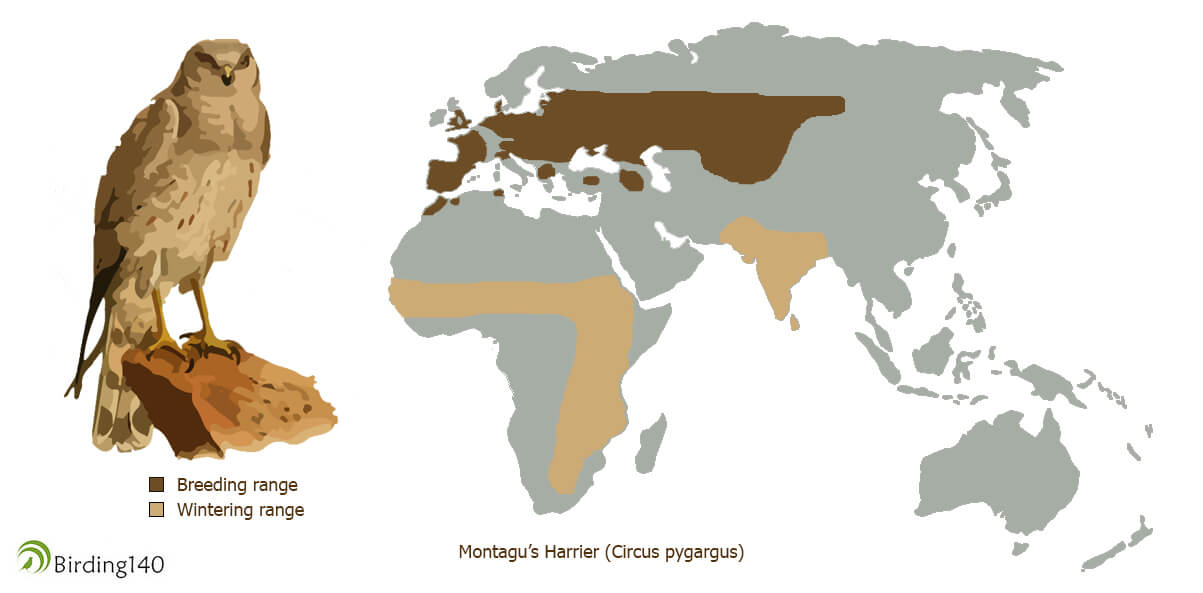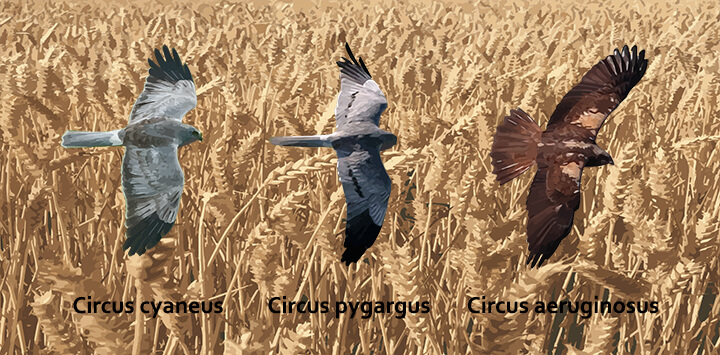Every year, between March and April, one of the birds of prey more linked to the agricultural sector crosses the Sahara and the Mediterranean to reach the large barley and wheat fields of the European continent. The Montagu’s Harrier has a strong reason for such a long and dangerous trip: the beginning of the nuptial season and the subsequent egg laying that will bring the next generation of harriers.
Before man spread cereal farming throughout the continent, harriers used to build their nests on the ground, hidden among the natural vegetation. Two thousand years ago, when cereal farming took a large part of the European territory, there was a successful cooperation between farmers and birds of prey.
The growing grain fields are the perfect camouflage for the harrier chicks to hide from foxes, wild boars, kites and other predators. Harriers pay their rent by cleaning the fields of rodents, voles and large insects, whose proliferation is harmful for the crops.
During the second half of the twentieth century, however, the bond between farmers and harriers started to break apart. The use of large harvesters and the increasingly earlier grain harvest is the cause of death for many chicks that have not yet learnt to fly when the harvesters arrive to the fields. On the other hand, the decrease in the population of harriers and other birds of prey forces farmers to use chemicals in order to control the periodic plagues of rodents, voles and insects.
Most of the Montagu’s Harrier population in western Europe is concentrated in France and Spain. To have information about the situation in these two countries is crucial to know if the European population is in good health or if it is by contrast threatened. According to the data from the Spanish census carried out in 2006, the Montagu’s Harrier population was stable, although some threats could already be foreseen as a consequence of agricultural changes.
When the last census was completed, it was planned to conduct periodical state censuses every 5 years. However, it has been 11 years and this task is still pending. It seems that the lack of resources and the little willingness from most administrations will translate in a delay of at least another 11 years until the next national census. It might be too late. It is possible that there are no harriers left when the new census is conducted.
We have asked five experts who are convinced about the imperative need of a census in 2017; each of them gives an argument for why a new harrier census in Spain is urgent and necessary.
1.- The census would help to correctly classify the species according to the IUCN Red List, and to be eligible for financing by the European Union for its protection.
By Beatriz Arroyo, researcher at the Institute for Game and Wildlife Research (IREC) (CSIC-UCLM-JCCM)
The situation of the Montagu’s Harrier in Spain seems to be very problematic. However, there are no comparable quantitative data that allow to make a correct estimation of the population trends. Without these quantitative data, and given the numerical importance of the Spanish population with regard to the total European population (excluding Russia), the truth is that nowadays, this species is still considered as “out of danger” (Least Concern) at international level, despite the situation observed in many European countries. Conducting a coordinated national census with the same methodology used in 2006 would help us get quantitative data about the observed population trends, which could probably enable to change the status of the species in the IUCN list.
Considering the Montagu’s Harrier a vulnerable species at European level, it would be possible to get European funding for its protection, for example, through the application for LIFE+Nature programmes, currently limited to SPA areas (which contain just a small fraction of the reproductive population in Spain) or to species of greater conservation status. There is currently a big interest in the development of international conservation programmes for the species; for this reason, having this information would put us in the right place for the development and involvement in those programmes.
2.- The census would allow to register not one, but three harrier species.
By Juan Carlos del Moral (SEO BirdLife)
Two of the three harrier species that breed in Spain, the Montagu’s and Northern Harrier, have very similar habitats. During breeding season, they occupy cereal cultivation areas, grasslands or sparse vegetation areas. Although their geographic distribution is overlapping to a great extent, there are light differences between them: the Montagu’s Harrier mostly breeds in average altitude areas, more linked to cereal crops (especially in the south and centre of the peninsula), while the Northern Harrier is more abundant in the northern half of the peninsula, occupying areas of even higher altitude. An important share of the Western Marsh Harrier’s population breeds in cereal crops, although their most typical breeding habitat is the marsh vegetation.
In addition to this overlapping habitat selection, the breeding phenology is also quite matching; for this reason, during the sampling carried out to identify the breeding pairs of a species, there are always specimens from the other species if their distribution points concur.
A simultaneous census of these species should take into consideration that their distribution change considerably across the years. In fact, during the first national census of the species, focused in areas with known and unknown distribution, the presence of both species was detected in some of the 193 grids with unknown presence. For this reason, a simultaneous field work should be carried out in the known and potential distributions for both species.
One of the key issues in combining the censuses is to arrange the visits when these species are more detectable; although they overlap in time, there are important regional differences. Samplings conducted before the onset of incubation, between mid-March and end of April ꟷdepending on the geographic areaꟷ are crucial in this regard, as well as the June and July samplings done to detect the couples that have successfully bred, although at this point not all the couples that have previously failed will be detected.
3. The partial data we have are alarming. The example of Extremadura.
By Antonio Pinilla (AMUS)
We’ve been carrying out a rescue campaign in Extremadura for 25 years, 17 of which we have been using the same methodology and effort. Nowadays, since 2006, the campaign is carried out by GEA (Extremaduran Harrier Group).
If we make a data history we can see that, despite the continuous rescue campaigns, the decrease in couples is alarming. Harriers have almost literally disappeared, especially in areas where there has been a radical habitat transformation due to crop changes, and they have concentrated in the areas that are still moderately preserved, although with numerous problems.
| Years | Controlled Pairs | Total Pairs | Fledgling | Productivity |
|---|---|---|---|---|
| 2006 |
621 |
700 | 913 | 1,46 |
|
2007 |
596 | 670 | 1436 | 2,41 |
|
2008 |
649 | 675 | 1190 | 1,83 |
|
2009 |
741 | 801 | 835 | 1,13 |
|
2010 |
654 | 654 | 927 | 1,44 |
|
2011 |
719 | 719 | 1236 | 1,72 |
| 2012 | 556 | 556 | 280 | 0,50 |
| 2013 | 335 | 494 | 583 | 1,74 |
| 2014 | 518 | 559 | 493 | 0,95 |
| 2015 | 439 | 494 | 465 | 1,06 |
| 2016 | 435 | 451 | 786 | 1,8 |
These data, together with the information shared by the working groups from other autonomous communities in the 2015 Congress of the Iberian Harrier Group, reveal that the species is clearly in decline in the Iberian Peninsula, and that it urgently needs interventions and preservation measures. This means that we should keep promoting rescue and awareness campaigns, as well as changes in agricultural policies and habitat management.
4. Iberian Harrier Congress in October and European Harrier Congress in spring 2018.
By Carlos Alberto Ramírez (SEO/BirdLife Salamanca Local Group)
The Local Group SEO-Salamanca, as the organizer of the XIV Iberian Harrier Congress that will be held on 20, 21 and 22 October later this year, considers this event as the ideal platform to spread among a large group of national and international experts the results of the necessary Montagu’s Harrier (Circus pigargus) national census, and hence of the evolution of the species’ populations.
We also understand the absolute need of having the results of the census in time for the congress (the previous census was carried out 10 years ago). It would provide us with the opportunity of developing specific working sessions, with focus on the updated data in order to address the challenge of their conservation, in light of what is assumed to be a dramatic decrease in their populations. It would also allow us to start considering the possibility of applying for European funding, in case the status of the species changes as expected.
Furthermore, an international congress will be held in France next spring; Spain should attend this congress with updated information to be able to propose the necessary strategies at European level for the conservation of the three species in the genus Circus.
5. The importance of carrying out a census and monitoring of the harrier population in Castile-Leon.
By Fernando Garcés (GREFA)
Considering the area and the cultivated hectares, the autonomous community of Castile-Leon acquires a significant importance in the peninsular territory for the harrier populations, and especially for the Montagu’s Harrier. It is thus paramount to accurately learn about the situation of the Montagu’s Harrier in the northern plateau, independently of the predictive models and population estimates.
During the last Montagu’s Harrier census carried out in 2006, there was an important population growth of the common vole (Microtus arvalis), which in the two following years caused a record-breaking plague in all the provinces of the northern plateau.
In 2017 we face a situation of certain resemblance to the period of the 2006 census, with an increase in the common vole density focused on some regions in Castile-Leon; for this reason, the 2017 Montagu’s Harrier census in Castile-Leon is even more necessary, if possible, to get the data in similar circumstances that would allow to assess the evolution of the Montagu’s Harrier population in a decade without significant biases.
Conclusion
We strongly believe that, unless a national harrier census is conducted, we will not have enough data to develop effective rescue campaigns in the Iberian Peninsula. The great effort that volunteers and a few autonomous communities make every spring and summer will only serve to slow down the disappearance of the Iberian harrier population, but not to avoid it.
We hope these five reasons are enough to convince you about the urgent need of carrying out a national harrier census. At least, we hope to have made you think for a few minutes about the situation of the species and the lack of data available to carry out truly effective conservation campaigns.
Let’s go for it! We need to conduct a harrier census in Spain, and we need to do it now!















